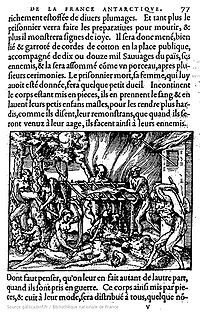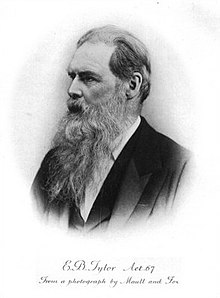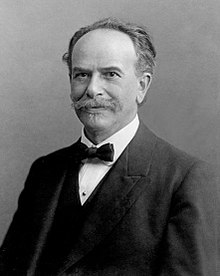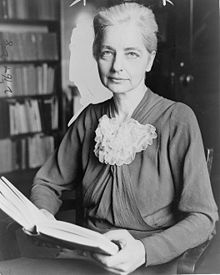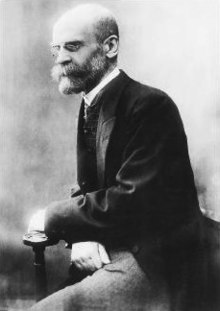History of anthropology
"[16] Harris agrees with the 19th-century view that laws are abstractions from empirical evidence: "...sociocultural entities are constructed from the direct or indirect observation of the behavior and thought of specific individuals ...."[17] Institutions are not a physical reality; only people are.
His text begins: "These are the researches of Herodotus of Halicarnassus ...." The Persia-based Achaemenid Empire, deciding to bring Greece into its domain, conducted a massive invasion across the Bosphorus using multi-cultural forces raised from many different locations, but were decisively defeated by the Greek city-states.
He identifies three terms of Herodotus as overlapping on culture: diaitia, material goods such as houses and consumables; ethea, the mores or customs; and nomoi, the authoritative precedents or laws.
According to Akbar S. Ahmed, like modern anthropologists, he engaged in extensive participant observation with a given group of people, learnt their language and studied their primary texts, and presented his findings with objectivity and neutrality using cross-cultural comparisons.
[32] The first use of the term "anthropology" in English to refer to a natural science of humanity was apparently in Richard Harvey's 1593 Philadelphus, a defense of the legend of Brutus in British history, which, includes the passage: "Genealogy or issue which they had, Artes which they studied, Actes which they did.
The traditions of jurisprudence, history, philology, and sociology then evolved into something more closely resembling the modern views of these disciplines and informed the development of the social sciences, of which anthropology was a part.
At the same time, the Romantic reaction to the Enlightenment produced thinkers, such as Johann Gottfried Herder[36] and later Wilhelm Dilthey, whose work formed the basis for the "culture concept", which is central to the discipline.
[citation needed] Institutionally, anthropology emerged from the development of natural history (expounded by authors such as Buffon) that occurred during the European colonization of the seventeenth, eighteenth, nineteenth and twentieth centuries.
Early anthropology was divided between proponents of unilinealism, who argued that all societies passed through a single evolutionary process, from the most primitive to the most advanced, and various forms of non-lineal theorists, who tended to subscribe to ideas such as diffusionism.
Curatorial practice has changed dramatically in recent years, and it would be wrong to see anthropology as merely an extension of colonial rule and European chauvinism, since its relationship to imperialism was and is complex.
As academic disciplines began to differentiate over the course of the nineteenth century, anthropology grew increasingly distinct from the biological approach of natural history, on the one hand, and from purely historical or literary fields such as Classics, on the other.
Such exhibitions were attempts to illustrate and prove in the same movement the validity of scientific racism, which first formulation may be found in Arthur de Gobineau's An Essay on the Inequality of Human Races (1853–1855).
Although Tylor undertook a field trip to Mexico, both he and Frazer derived most of the material for their comparative studies through extensive reading, not fieldwork, mainly the Classics (literature and history of Greece and Rome), the work of the early European folklorists, and reports from missionaries, travelers, and contemporaneous ethnologists.
[40] Tylor formulated one of the early and influential anthropological conceptions of culture as "that complex whole, which includes knowledge, belief, art, morals, law, custom, and any other capabilities and habits acquired by [humans] as [members] of society".
Cambridge University financed a multidisciplinary expedition to the Torres Strait Islands in 1898, organized by Alfred Cort Haddon and including a physician-anthropologist, William Rivers, as well as a linguist, a botanist, and other specialists.
A decade and a half later, Polish anthropology student Bronisław Malinowski (1884–1942) was beginning what he expected to be a brief period of fieldwork in the old model, collecting lists of cultural items, when the outbreak of the First World War stranded him in New Guinea.
British social anthropology had an expansive moment in the Interwar period, with key contributions coming from the Polish-British Bronisław Malinowski and Meyer Fortes[43] A. R. Radcliffe-Brown also published a seminal work in 1922.
However, after reading the work of French sociologists Émile Durkheim and Marcel Mauss, Radcliffe-Brown published an account of his research (entitled simply The Andaman Islanders) that paid close attention to the meaning and purpose of rituals and myths.
It was in this context that the so-called American School of Anthropology thrived as the champion of polygenism or the doctrine of multiple origins—sparking a debate between those influenced by the Bible who believed in the unity of humanity and those who argued from a scientific standpoint for the plurality of origins and the antiquity of distinct types.
In the immediate wake of Types of Mankind and during the pitched political battles that led to Civil War, Frederick Douglass (1818–1895), the statesman and persuasive abolitionist, directly attacked the leading theorists of the American School of Anthropology.
Like other scholars of his day (such as Edward Tylor), Morgan argued that human societies could be classified into categories of cultural evolution on a scale of progression that ranged from savagery, to barbarism, to civilization.
His first generation of students included Alfred Kroeber, Robert Lowie, Edward Sapir and Ruth Benedict, who each produced richly detailed studies of indigenous North American cultures.
Influenced by psychoanalytic psychologists including Sigmund Freud and Carl Jung, these authors sought to understand the way that individual personalities were shaped by the wider cultural and social forces in which they grew up.
Boas had planned for Ruth Benedict to succeed him as chair of Columbia's anthropology department, but she was sidelined by Ralph Linton, and Mead was limited to her offices at the American Museum of Natural History (AMNH).
Anthropology as it emerged amongst the Western colonial powers (mentioned above) has generally taken a different path than that in the countries of southern and central Europe (Italy, Greece, and the successors to the Austro-Hungarian and Ottoman empires).
[51] In Italy, the development of ethnology and related studies did not receive as much attention as other branches of learning,[52] but nonetheless included important researchers and thinkers like Ernesto De Martino.
Some of his remarkable books were Bharater Ditiya Swadhinatar Sangram (1949), Bharatiyo Samaj Padhyati (1958), Amar Amerikar Abhijnata (1933), Baishnab Sahitye Samajtatta (1945), Banglar Itihas (1963), Hindu Law of Inheritance (1957), Dialectics of Land Economics of India (1952) and Swami Vivekananda: Patriot-Prophet—a study (1954).
If he also accepts this ideal, then, with his superior analytical apparatus, and the use of comparisons and synthetic thinking, he can suggest many modifications in the ways in which the government or leaders of society are trying to bring about justice where injustice prevails today.
Das's firsthand empirical information on Bengal famine was profusely used by the Nobel Laureate economist Amartya Sen and the American historian Mark Tauger to build their own theoretical formulations on famine and Bengali society and culture under acutely critical conditions[112][113] Das's another earlier study on the Purum Kuki tribe of the north-east India also became well-known at the national and international levels since the data presented by Das in his book The Purums: An Old Kuki tribe of Manipur published in 1945 by the Calcutta University became one of the major sources of database in the acrimonious debate on descent versus alliance theories on kinship in Anglo-American Anthropology which involved mavericks like Claude Levi-Strauss, George Homans, David Schneider, Rodney Needham, Floyd Lounsbury and others.
[120][121] The application of anthropological knowledge for the development and welfare of the tribal populations in the post-independence period became a major thrust area of study for the anthropologists and notable contributions in this field were made by Verrier Elwin, Christoph von Fürer-Haimendorf, L.P. Vidyarthi, B.N.
